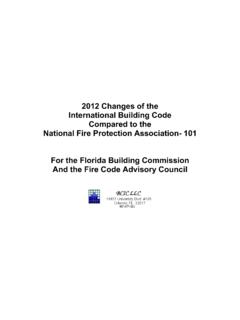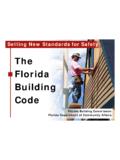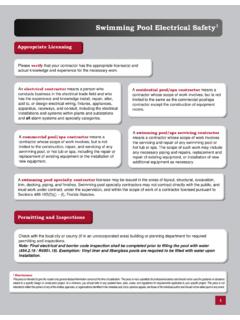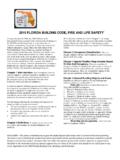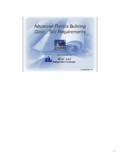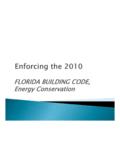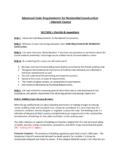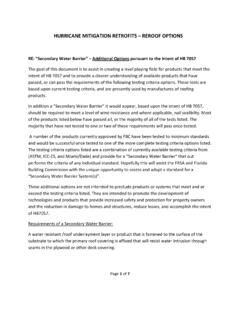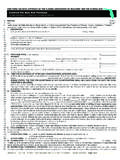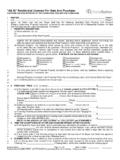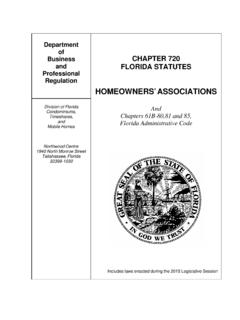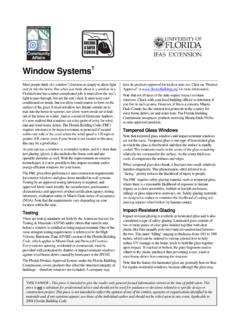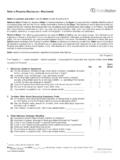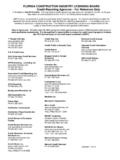Transcription of Fenestration Mitigation Advanced Class - Florida Building
1 Florida Building Code, 5thEdition (2014) Fenestration Mitigation Advanced Class Florida AIAI nstructor .. Jim Heise 343-7122 (Cell)Copyright MaterialsThis presentation is protected by and International Copyright laws. Reproduction, distribution, display and use of the presentation without written permission of the speaker is prohibited. Florida AIA 2015 AIA Florida is a Registered Provider with The American Institute of Architects Continuing Education Systems. Credit earned on completion of this program will be reported to CES Records for AIA members. Certificates of Completion for non-AIA members are available on program is registered with the AIA/CES for continuing professional education. As such, it does not include content that may be deemed or construed to be an approval or endorsement by the AIA of any material of construction or any method or manner of handling, using, distributing, or dealing in any material or product.
2 Questions related to specific materials, methods, and services will be addressed at the conclusion of this Continuing EducationObjective ..To provide an understanding of the Mitigation options & codes available within the Florida Building Code, 5thEdition (2014) as it relates to Building Code 5thEdition (2014) FBC Update, 5thEdition (2014) Uses 2012 ICC as its Base Code as required by Florida Legislature .. Causing sections to be changed Books are even larger due to sections referring to things like seismic and snow loadsare no longer eliminated Residential & Commercial Energy Codes are totally separated within the same bookSwing DoorA Typical Example of a Florida Specific Amendment .. Mod 5415 allows for outwardswing door over step for residential use Supported by the Florida Home Builders AssociationLegislature The Legislature passed provisions to delay three elements of the 5th edition Florida Building Code for one year (until June 30, 2016), which are mandatory blower door testing, new mechanical ventilation requirements, and the secondary fire elevator for high-rises.
3 Governor Scott signed budget line item 2250 that provides a study on the economic and health impacts of complying with these provisionsAgenda Mitigation Basics Reasons for Opening Protection Testing & Label Requirements Wind-borne Debris Protection Relevant Florida Building Codes NOA s & Florida Product Approvals Energy Changes ResourcesMitigation BasicsMitigation BasicsDefinition:1. The act of mitigating, or lessening the forceor intensity of something unpleasant, as wrath, pain, grief, or extreme The act of making a condition or consequence less severe. 3. The process of becoming milder, gentler, or less severe. Mitigation BasicsAccording to FEMA .. For every $1 spent on Mitigation , $4 in post storm cleanup and rebuilding is saved! While Mitigation will never eliminate the risk to homeowners, it will reduce loss, and in many cases save a families for Opening Protection61 Year History of Hurricane StrikesEarthquake DevastationHaiti Earthquake magnitude 280,000 buildingsdestroyed More than 200,000 deathsJanuary 2010 Improved Building CodesFebruary 2010 Chile Earthquake magnitude 500 times strongerthan the Haiti earthquake 500,000 buildings destroyed More than 795deathsLandfall FrequencyPositive & Negative Design PressuresPositive Design PressuresNegative Design PressuresWhen an opening is breached,internal pressureis effectively doubled!
4 Interior and End Zones4'4'4'4'1333322122224'4'4'4'1333322 122224'4'3333224'123222111333224'4'4'4'4 '22222222 WallsGable Roofs 10 Gable Roofs 10 <0 45 Hip Roofs 10 <0 30 E N D Z O N E SI N T E R I O R Z O N E SE N D Z O N E S455thEdition (2014) Florida Building Code: ResidentialTesting & Label RequirementsTestingSection Labeling. Exterior windows and glass doors shall be tested by an approvedindependent testing laboratory, and shall be labeledto indicate compliance with the requirements of one of the following specifications: ANSI/AAMA/NWWDA 101 2 or ANSI/AAMA/WDMA/101 or AAMA/WDMA/CSA 101 or TAS 202 (HVHZ shall comply with TAS 202 utilizing ASTM E 1300 or Section 2404). Florida Building Code, 5thEdition (2014): BuildingAAMA 101-97 (FL Product Approval)Non-Impact TestTesting Order Air Infiltration Water Infiltration Full Structural Load (10 seconds) Forced EntryFlorida Building Code, 5thEdition (2014): ResidentialTAS 202 (Miami-Dade NOA)Non-Impact TestTesting Order Air Infiltration Structural Load +/ (30 seconds) Water Infiltration Full Structural Load (30 seconds) Forced EntryFlorida Building Code , 5thEdition (2014).
5 ResidentialASTM E 1996 Impact Test RequirementsLevel of ProtectionEnhanced Protection(Essential Facilities)Basic ProtectionUnprotectedAssembly Height 30 ft>30 ft 30 ft>30 ft 30 ft>30 ftWind Zone ICCB ANoneNoneWind Zone IICCB ANoneNoneWind Zone IIIDDCANoneNoneWind Zone IVE DDANoneNone Missile Level A (Small Missile)Ten 2 gram steel balls shot at 130 feet/second Missile Level B2 lb (1 9 ) 2x4 shot at 50 feet/second Missile Level lb (4 4 ) 2x4 shot at 40 feet/second Missile Level D9 lb (8 4 ) 2x4 shot at 50 feet/second Missile Level E9 lb (8 4 ) 2x4 shot at 80 feet/secondFlorida Building Code, 5thEdition (2014): ResidentialASTM E 1996 (FL Product Approval)Impact and Missile lb. 2x4 @40 fps Test 3 specimens No structural shot (140 mph & below) Air Pressure Cycling 4500 Positive, 4500 Negative cycles No tear greater than 5 or an opening up to 3 in diameter Not acceptable in HVHZF lorida Building Code, 5thEdition (2014): ResidentialTAS 201 & 203 (Miami-Dade NOA)Impact TestLarge Missile 9 lb.
6 2x4 @ 50 fps. 3 specimens 2 impacts each Two specimens are required to take a structural shot Air Pressure Cycling 4500 Positive, 4500 Negative cycles No tear over 1/16 x 5 Accepted statewideFlorida Building Code, 5thEdition (2014): ResidentialTest ComparisonsASTM TestingTAS TestingFlorida Building Code, 5thEdition (2014): ResidentialCyclic Wind LoadsCyclic Wind Load Test Product is cycled to engineered maximum design pressure Completed on impact resistant products onlyFlorida Building Code, 5thEdition (2014): ResidentialFlorida Product ApprovalFlorida state law, Rule 61G20-3 specifies that allparts of the Building envelope must havethird-party QA through a state- approved entityQA must be documented in either: Florida Product Approval (statewide) Local Product Approval (county by county) Building Officials must accept Florida Product Approvals. Additional info may be required at officials discretionFlorida Building Code, 5thEdition (2014): ResidentialLabelingSection windows and doors.
7 Exterior windows and doors shall be tested by an approved independent testing laboratory, and shall be labeled to indicate compliance with the requirements of one of the following specifications: ANSI/AAMA/NWWDA 101 2 or 101 NAFS or AAMA/WDMA/CSA 101 or TAS 202 (HVHZ shall comply with TAS 202 utilizing ASTM E 1300 or Section 2404). Florida Building Code, 5thEdition (2014): BuildingLabelingSection and Labeling. Exterior windows and doors shall be tested by an approved independent testing laboratory, and shall labeled with an approved permanent label identifying the manufacturer, the products model/series number, performance characteristics and approved product certification agency, testing laboratory, evaluation entity or Miami-Dade Product Approval to indicate compliance with the requirements of one of the following specifications:ANSI/AAMA/NWWDA 101 or 101 NAFS or AAMA/WDMA/CSA 101 or TAS 202 (HVHZ shall comply with TAS 202 utilizing ASTM E 1300-98 or ASTM 1300-04 02).
8 Florida Building Code, 5thEdition (2014): Residential Ages new glass 20 years Reduces glass strength 12 Tables specific to glass thickness The Florida Building Code requires editions of ASTM E1300-04e01, E1300-07e01, or E1300-09a to be used. (E1300-98 in HVHZ)ASTM E1300-98/04 Glass Table Florida Building Code, 5thEdition (2014): ResidentialRequired Testing LabelExample of a self label with Miami-Dade NOATest entityWarranty void if label Building Code, 5thEdition (2014): ResidentialManufacturers Glass IdentificationSection pane shall bear the manufacturer s mark designating the type and thickness of the glass or glazing material. With the exception of tempered glazing materials or laminated materials, the identification shall not be omitted unless approvedand an affidavit is furnished by the glazing contractor certifying that each light is glazed in accordance with approvedconstruction documentsthat comply with the provisions of this chapter.
9 Safety glazing shall be identified in accordance with Section Each pane of tempered glassshall be permanently identified by the manufacturer and each pane of laminated glass shall be permanently identified with the laminator, overall glass thickness and trade name of interlayer. The identification markshall be acid etched, ceramic fired, laser etched, embossed, sand etching or of a type that, once applied, cannot be removed without being destroyed. Tempered or laminated spandrel glass shall be provided with a removable paper marking by the Building Code, 5thEdition (2014): BuildingOverall Laminated Glass Thickness S afety G lazing C ouncil C ertification NumberLaminatorLogo M iami D ade C ounty A pproved L aminated S afety G lass Required by Code for all Safety Glazing ANSI Standard for plastic materials used in safety glazingFlorida Building Code, 5thEdition (2014): BuildingFlorida Building Code, 5thEdition (2014): BuildingWind-Borne Debris Protection Protection of openings Wind-Borne Debris Regions OptionsBuilding CodeSection Protection of wind-borne debris regions,glazed openings in buildings shall be impact resistant or protected with an impact-resistant covering meeting the requirements of SSTD 12, ANSI/DASMA 115 (for garage doors and rolling doors) or TAS 201, 202 and 203, AAMA 506.
10 ASTM E 1996 and ASTM E 1886, referenced herein, or an approvedimpact-resistant standard as follows:1. Glazed openings located within 30 feet (9144mm) of grade shall meet the requirements of the large missile test of ASTM E 1996 2. Glazed opening located more than 30 feet (9144mm) above grade shall meet the provisions of the small missile test of ASTM E 1996 in Occupancy Category II, III or IV buildings located over 60 feet above the ground and over 30 feet above aggregate surface roofs located within 1,500 feet of the Building shall be permitted to be Building Code, 5thEdition (2014): BuildingOpening ProtectionFlorida Building Code, 5thEdition (2014): BuildingResidential CodeSection Protection of openings in buildings located in windborne debris regions shall be protected from windborne debris. Glazed opening protection for windborne debris shall meet the requirements of the Large Missile Test of ASTM E1996 and ASTM E1886 referenced therein, SSTD 12, TAS 201, 202 and 203 or AAMA 506, as applicable.
